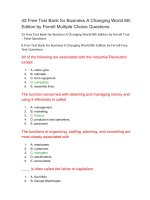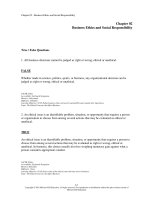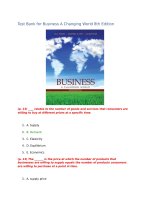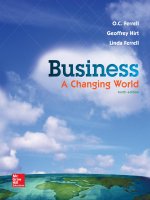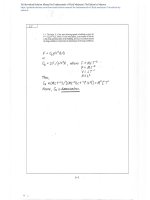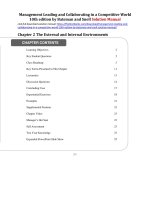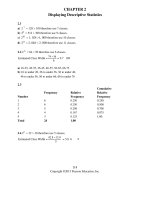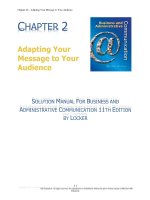download solution manual for business a changing world 10th edition by ferrell hirt and ferrell
Bạn đang xem bản rút gọn của tài liệu. Xem và tải ngay bản đầy đủ của tài liệu tại đây (925 KB, 39 trang )
Solution manual for Business A Changing World 10th
Edition by O.C.Ferrell, Geoffrey A.Hirt and Linda Ferrell
Chapter 2: Business Ethics and Social Responsibility
Use this Instructor’s Manual to facilitate class discussion and incorporate the unique features of the text’s
highlights. Follow-up via the Connect exercises is then encouraged to provide a holistic understanding of
the chapter.
CHAPTER FORECAST
In this chapter, we take a look at the role of ethics and social responsibility in business decision making. First
we define business ethics and examine why it is important to understand ethics’ role in business. Next we
explore a number of business ethics issues to help you learn to recognize such issues when they arise.
Finally, we consider steps businesses can take to improve ethical behavior in their organizations. The second
half of the chapter focuses on social responsibility and unemployment. We survey some important issues
and detail how companies have responded to them.
LEARNING OBJECTIVES
LO 2-1 Define business ethics and social responsibility and examine their importance.
LO 2-2 Detect some of the ethical issues that may arise in business.
LO 2-3 Specify how businesses can promote ethical behavior.
LO 2-4 Explain the four dimensions of social responsibility.
LO 2-5 Debate an organization’s social responsibilities to owners, employees, consumers, the environment,
and the community.
LO 2-6 Evaluate the ethics of a business’s decision.
LEARN THE TERMS
bribes (p. 40)
corporate citizenship (p. 52)
ethical issue (p. 39)
consumerism (p. 55)
sustainability (p. 56) business ethics (p. 36)
whistleblowing (p. 50) codes of ethics (p. 49)
plagiarism (p. 48)
social responsibility (p. 36)
1 Instructor’s Manual – Chapter 2 | Ferrell / Hirt / Ferrell: Business © 2016 by McGraw-Hill Education.
This is proprietary material solely for authorized instructor use. Not authorized for sale or distribution in any
manner. This document may not be copied, scanned, duplicated, forwarded, distributed, or posted on a website, in
whole or part.
Solution manual for Business A Changing World 10th
Edition by O.C.Ferrell, Geoffrey A.Hirt and Linda Ferrell
KEYTERMS ANDDEFINITIONS
bribes
Payments, gifts, or special favors intended to influence the outcome of a
decision.
business ethics
Principles and standards that determine acceptable conduct in business.
codes of ethics
Formalized rules and standards that describe what a company expects of
its employees.
consumerism
The activities that independent individuals, groups, and
organizations undertake to protect their rights as consumers.
corporate citizenship
The extent to which businesses meet the legal, ethical, economic,
and voluntary responsibilities placed on them by their stakeholders.
ethical issue
An identifiable problem, situation, or opportunity that requires a person to
choose from among several actions that may be evaluated as right or
wrong, ethical or unethical.
plagiarism
The act of taking someone else’s work and presenting it as your own
without mentioning the source.
social responsibility
A business’s obligation to maximize its positive impact and minimize
its negative impact on society.
sustainability
Conducting activities in a way that allows for the long-term well-being of the
natural environment, including all biological entities. Sustainability involves
the assessment and improvement of business strategies, economic sectors,
work practices, technologies, and lifestyles so that they maintain the health of
the natural environment.
whistleblowing
The act of an employee exposing an employer’s wrongdoing to outsiders,
such as the media or government regulatory agencies.
2 Instructor’s Manual – Chapter 2 | Ferrell / Hirt / Ferrell: Business © 2016 by McGraw-Hill Education.
This is proprietary material solely for authorized instructor use. Not authorized for sale or distribution in any
manner. This document may not be copied, scanned, duplicated, forwarded, distributed, or posted on a website, in
whole or part.
Solution manual for Business A Changing World 10th
Edition by O.C.Ferrell, Geoffrey A.Hirt and Linda Ferrell
CONTENT OUTLINE
The following section provides the flow of information using the LEARNING OBJECTIVES as a guide, KEY
TERMS learners will need to take away from the course and a notation of when to use POWERPOINT SLIDES
with LECTURE NOTES to drive home teaching points. There is also a reminder on when CONNECT activities can
be used. This is created so that you can facilitate in-class or online discussion effectively.
LO 21
Define business ethics and social responsibility and examine
their importance.
• Introduction
Key Terms:
•
Business ethics
•
Social responsibility
• Business Ethics and Social Responsibility
• The Role of Ethics in Business
3 Instructor’s Manual – Chapter 2 | Ferrell / Hirt / Ferrell: Business © 2016 by McGraw-Hill Education.
This is proprietary material solely for authorized instructor use. Not authorized for sale or distribution in any
manner. This document may not be copied, scanned, duplicated, forwarded, distributed, or posted on a website, in
whole or part.
Solution manual for Business A Changing World 10th
Edition by O.C.Ferrell, Geoffrey A.Hirt and Linda Ferrell
PowerPoint Slides
PPT 2.4
Lecture Outline and Notes:
I.
Business Ethics and Social Responsibility
A. Business ethics are principles and standards that determine
acceptable conduct in business
B. Acceptable behavior is determined by:
1. The organization
2. Stakeholders and interest groups
3. Competitors
4. Government regulators
5. The public
PPT 2.5
6. The individual’s personal principles
C. Global Trust in Different Institutions (Figure 2.1)
1. In business, trust is the glue that holds the customer
relationship together
PPT 2.6
2. The recent global financial crisis took a toll on consumer trust
of financial services companies
D. “Tone from the top”
1. Managers must show a strong commitment to ethics
and compliance
2. “Tone from the top” requires top managers to acknowledge
their own role in supporting ethics and compliance
4 Instructor’s Manual – Chapter 2 | Ferrell / Hirt / Ferrell: Business © 2016 by McGraw-Hill Education.
This is proprietary material solely for authorized instructor use. Not authorized for sale or distribution in any
manner. This document may not be copied, scanned, duplicated, forwarded, distributed, or posted on a website, in
whole or part.
Solution manual for Business A Changing World 10th
Edition by O.C.Ferrell, Geoffrey A.Hirt and Linda Ferrell
3. Top managers must:
a.
Create strong relationships with ethics and
compliance department
b.
Clearly communicate expectations for ethical behavior to all
employees
c.
Educate managers/supervisors about the company’s
ethics policies
d.
Train managers and employees on what to do if an ethics
crisis occurs
PPT 2.7
E. Social responsibility is a business’s obligation to maximize its
positive impact and minimize its negative impact on society
1. Social responsibility and ethics are not the same
PPT 2.8
a.
Ethics refers to individual’s or work group’s decisions
b.
Social responsibility is the impact of the entire organization’s
activities on society
F. Laws and regulations
1. Timeline of Ethical and Socially Responsible Activities (Table 2.1)
2. Sarbanes-Oxley Act
a.
Criminalized securities fraud and stiffened penalties
for corporate fraud
b.
Enacted after the accounting scandals in the early 2000’s
3. Dodd-Frank Act
PPT 2.9
a.
Passed to reform the financial industry and offer consumers
protection against complex and/or deceptive financial
products
b.
Enacted after the most recent recession
The Role of Ethics in Business
A. Growing concerns about legal and ethical issues in business strengthen
the public’s perceptions that ethical standards and the level of trust
in business need to be raised
1. Recent legal and ethical issues:
a. Subprime loans and foreclosures
II.
5 Instructor’s Manual – Chapter 2 | Ferrell / Hirt / Ferrell: Business © 2016 by McGraw-Hill Education.
This is proprietary material solely for authorized instructor use. Not authorized for sale or distribution in any
manner. This document may not be copied, scanned, duplicated, forwarded, distributed, or posted on a website, in
whole or part.
Solution manual for Business A Changing World 10th Edition by
O.C.Ferrell, Geoffrey A.Hirt and Linda Ferrell
b. Accounting fraud
c. Cybercrimes
d. Deceptive advertising
e. Unfair competitive practices
2. Learning to recognize and resolve ethical issues is a key step
in evaluating ethical decisions
6 Instructor’s Manual – Chapter 2 | Ferrell / Hirt / Ferrell: Business © 2016 by McGraw-Hill Education.
This is proprietary material solely for authorized instructor use. Not authorized for sale or distribution in any
manner. This document may not be copied, scanned, duplicated, forwarded, distributed, or posted on a website, in
whole or part.
Solution manual for Business A Changing World 10th
Edition by O.C.Ferrell, Geoffrey A.Hirt and Linda Ferrell
LO 22
Detect some of the ethical issues that may arise in business.
Key Terms:
•
Ethical issue
Business o Fairness and Honesty
•
Bribes
o
•
Plagiarism
o
Recognize Ethical Issues in
Making Decisions about Ethical
Issues
7 Instructor’s Manual – Chapter 2 | Ferrell / Hirt / Ferrell: Business © 2016 by McGraw-Hill Education.
This is proprietary material solely for authorized instructor use. Not authorized for sale or distribution in any
manner. This document may not be copied, scanned, duplicated, forwarded, distributed, or posted on a website, in
whole or part.
Solution manual for Business A Changing World 10th
Edition by O.C.Ferrell, Geoffrey A.Hirt and Linda Ferrell
PPT 2.10
B. Recognizing ethical issues
1. Ethical issue is an identifiable problem, situation, or opportunity that
requires a person to choose from among several actions that may be
evaluated as right or wrong, ethical or unethical
2. Recognizing
ethical issues
important
step
in
understanding business ethics
PPT 2.12
is
the
most
3. Best way to judge the ethics of a decision is to look at a situation from
a customer’s or competitor’s viewpoint
C. Bribes are payments, gifts, or special favors intended to influence
the outcome of a decision
1. Many business issues seem straightforward and easy to resolve on
the surface, but are in reality very complex
2. Experience with the culture in which a business operates is critical to
understanding what is ethical or unethical
PPT 2.13
PPT 2.14
3. One of the principal causes of unethical behavior in organizations is
overly aggressive financial or business objectives
D. Percentage of U.S. Workforce Observing Specific Forms of Misconduct,
2011-2013 (Table 2.2)
E. Misuse of Company Time
1. Theft of time is a common area of misconduct observed in the
workplace
2. Many employees spend an average of 1 hour/day using social media
sites or watching YouTube
PPT 2.15
3. Time theft costs are estimated to cost companies hundreds of
billions of dollars annually
F. Abusive or intimidating behavior is the most common ethical
problem for employees
1. Bullying is associated with a hostile workplace when a person or
group is targeted and is threatened, harassed, belittled, verbally
abused, or overly criticized
a. Within the concept of abusive behavior, intent should be
a consideration
8 Instructor’s Manual – Chapter 2 | Ferrell / Hirt / Ferrell: Business © 2016 by McGraw-Hill Education.
This is proprietary material solely for authorized instructor use. Not authorized for sale or distribution in any
manner. This document may not be copied, scanned, duplicated, forwarded, distributed, or posted on a website, in
whole or part.
Solution manual for Business A Changing World 10th Edition by
O.C.Ferrell, Geoffrey A.Hirt and Linda Ferrell
b. Abusive behavior is difficult to assess and manage because of
diversity in culture and lifestyle
9 Instructor’s Manual – Chapter 2 | Ferrell / Hirt / Ferrell: Business © 2016 by McGraw-Hill Education.
This is proprietary material solely for authorized instructor use. Not authorized for sale or distribution in any
manner. This document may not be copied, scanned, duplicated, forwarded, distributed, or posted on a website, in
whole or part.
Solution manual for Business A Changing World 10th
Edition by O.C.Ferrell, Geoffrey A.Hirt and Linda Ferrell
PPT 2.16
G. Actions Associated with Bullies (Table 2.3)
PPT 2.17
H. Misuse of company resources has been identified as a leading issue in
observed misconduct in organizations
1. Issues might include:
a. Spending an excessive amount of time on personal e-mails
b. Submitting personal expenses on company expense reports
c. Using the company copier for personal use
PPT 2.18
I.
2. Many companies have implemented official policies
delineating acceptable use of company resources
Conflict of Interest
1. Exists when a person must choose whether to advance his or her
own personal interests or those of others
2. To avoid, employees must be able to separate their
personal financial interests from their business dealings
3. Inside trading is the buying or selling of stocks by insiders who possess
material that is still not public Fairness and Honesty
PPT 2.19
J.
1. Employees must:
a. Abide by the laws
b. Cause no harm through dishonesty
c. Use company resources fairly and honestly
d. Be aware of company policies
PPT 2.20
e. Recognize ethical behavior
2. Companies must:
a. Use fair competition practices
b. Give full disclosure of potential harm by a product
c. Be truthful in advertising
d. Keep company secrets
e. Meet obligations
10 Instructor’s Manual – Chapter 2 | Ferrell / Hirt / Ferrell: Business © 2016 by McGraw-Hill Education.
This is proprietary material solely for authorized instructor use. Not authorized for sale or distribution in any
manner. This document may not be copied, scanned, duplicated, forwarded, distributed, or posted on a website, in
whole or part.
Solution manual for Business A Changing World 10th
Edition by O.C.Ferrell, Geoffrey A.Hirt and Linda Ferrell
PPT 2.21
f. Avoid undue pressure forcing others to act unethically
3. Plagiarism is taking someone else’s work and presenting it as your
own without mentioning the source
11 Instructor’s Manual – Chapter 2 | Ferrell / Hirt / Ferrell: Business © 2016 by McGraw-Hill Education.
This is proprietary material solely for authorized instructor use. Not authorized for sale or distribution in any
manner. This document may not be copied, scanned, duplicated, forwarded, distributed, or posted on a website, in
whole or part.
Solution manual for Business A Changing World 10th
Edition by O.C.Ferrell, Geoffrey A.Hirt and Linda Ferrell
PPT 2.22
K. Making Decisions about Ethical Issues
1. It can be difficult to recognize specific ethical issues
2. People often need years of experience to accurately recognize and
react to ethical situations
3. Questions to Consider in Determining Whether an Action is Ethical
(Table 2.5)
LO 23
Specify how businesses can promote ethical behavior.
o Improving Ethical Behavior in Business
Key Terms:
o Codes of ethics o
Whistleblowing
12 Instructor’s Manual – Chapter 2 | Ferrell / Hirt / Ferrell: Business © 2016 by McGraw-Hill Education.
This is proprietary material solely for authorized instructor use. Not authorized for sale or distribution in any
manner. This document may not be copied, scanned, duplicated, forwarded, distributed, or posted on a website, in
whole or part.
Solution manual for Business A Changing World 10th
Edition by O.C.Ferrell, Geoffrey A.Hirt and Linda Ferrell
PPT 2.23
L. Improving Ethical Behavior in Business
1. Three factors that influence business ethics (Figure 2.2):
a. Individual Standards and Values
b. PLUS Managers’ and Co-Workers’ Influence
c. PLUS Opportunity: Codes and Compliance Requirements
d. EQUAL Ethical/Unethical Choices in Business
2. Many employees use different ethical standards at work than they
do at home
3. The activities and examples set by managers and co-workers are
critical in gaining consistent ethical compliance
4. If a company fails to provide good examples and direction, confusion
and conflict will develop
2.25
a. Leading to unethical choices in business
M. Codes of ethics are formalized rules and standards that describe what
a company expects of its employees
1. Employees must have established ethics policies if employees are to
determine what conduct is acceptable
2. Codes and policies on ethics encourage the creation of an ethical
culture in the company
3. The enforcement of ethical codes and policies through rewards and
punishments increases the acceptance of ethical standards by
employees
13 Instructor’s Manual – Chapter 2 | Ferrell / Hirt / Ferrell: Business © 2016 by McGraw-Hill Education.
This is proprietary material solely for authorized instructor use. Not authorized for sale or distribution in any
manner. This document may not be copied, scanned, duplicated, forwarded, distributed, or posted on a website, in
whole or part.
Solution manual for Business A Changing World 10th
Edition by O.C.Ferrell, Geoffrey A.Hirt and Linda Ferrell
PPT 2.26
N. Whistleblowing is the act of an employee exposing an employer’s
wrongdoing to outsiders such as the media or government regulatory
agencies
1. One of the most important components of an ethics program is a
means through which employees can report observed misconduct
anonymously
2. More companies are establishing programs to encourage employees
to report illegal or unethical practices internally
3. In 2010, Congress passed the Dodd-Frank Act, which includes a
“whistleblower bounty program”
PPT 2.27
O. Improving Ethical Behavior in Business
1. The current trend is to move away from legally based ethical
programs to cultural or integrity-based programs that make ethics a
core organizational value
2. Effective business
ethics programs
for
business performance
are
good
3. Firms that develop higher levels of trust function more efficiently and
effectively and avoid damaged company reputations and product
images
LO 24
Explain the four dimensions of social responsibility.
Key Terms:
The Nature of Social Responsibility
PPT 2.28
Corporate citizenship
III. The Nature of Social Responsibility
A. Four Dimensions of Social Responsibility (Figure 2.3)
connect
Need help
understanding social
responsibility? Visit
your Connect ebook
video tab for a brief
animated
explanation.
1. Voluntary responsibilities: Being a “good corporate citizen”;
contributing to the community and quality of life
2. Ethical responsibilities: Being ethical; doing what is right, just, and
fair; avoiding harm
3. Legal responsibilities: Obeying the law (society’s codification of right
and wrong); playing by the rules of the game
4. Economic responsibilities: Being profitable
14 Instructor’s Manual – Chapter 2 | Ferrell / Hirt / Ferrell: Business © 2016 by McGraw-Hill Education.
This is proprietary material solely for authorized instructor use. Not authorized for sale or distribution in any
manner. This document may not be copied, scanned, duplicated, forwarded, distributed, or posted on a website, in
whole or part.
Solution manual for Business A Changing World 10th
Edition by O.C.Ferrell, Geoffrey A.Hirt and Linda Ferrell
PPT 2.29
B. Corporate citizenship is the extent to which businesses meet the legal,
ethical, economic, and voluntary responsibilities placed on them by
their stakeholders
1. Commitment to corporate citizenship indicates a strategic focus on
fulfilling the social responsibilities expected of it by its stakeholders
2. Involves action and measurement of the extent to which a firm
embraces corporate citizenship philosophy and following through by
implementing appropriate initiatives
PPT 2.30
C. The Arguments For and Against Social Responsibility (Table 2.8)
LO 2-5
Debate an organization’s social responsibilities to owners,
employees, consumers, the environment, and the community.
o Social Responsibility
Issues
Key Terms:
•
Consumerism
•
Sustainability
Unemployment
15 Instructor’s Manual – Chapter 2 | Ferrell / Hirt / Ferrell: Business © 2016 by McGraw-Hill Education.
This is proprietary material solely for authorized instructor use. Not authorized for sale or distribution in any
manner. This document may not be copied, scanned, duplicated, forwarded, distributed, or posted on a website, in
whole or part.
Solution manual for Business A Changing World 10th
Edition by O.C.Ferrell, Geoffrey A.Hirt and Linda Ferrell
IV. Social Responsibility Issues
PPT 2.31
A. Managers consider social responsibility on a daily basis.
1. Among the many social issues that mangers must consider are their
firms’ relations with:
PPT 2.32
a.
Owners and stockholders
b.
Employees
c.
Consumers
d.
The environment
e.
The community
B. Company’s Responsibility to Owners and Stockholders
1. Maintaining proper accounting procedures
2. Providing investors with all relevant information
PPT 2.33
3. Protecting owner’s rights and investments
C. Company’s Responsibilities to Employees
1. Provide a safe workplace and pay them adequately
2. Provide equal opportunities for all employees
3. Keep them informed of what is happening in the company
4. Listen to their grievances and treat them fairly
16 Instructor’s Manual – Chapter 2 | Ferrell / Hirt / Ferrell: Business © 2016 by McGraw-Hill Education.
This is proprietary material solely for authorized instructor use. Not authorized for sale or distribution in any
manner. This document may not be copied, scanned, duplicated, forwarded, distributed, or posted on a website, in
whole or part.
Solution manual for Business A Changing World 10th
Edition by O.C.Ferrell, Geoffrey A.Hirt and Linda Ferrell
PPT 2.34
D. Consumerism involves the activities that independent individuals, groups,
and organizations undertake to protect their rights as consumers
1. Write letters
2. Lobby government agencies
3. Make public service announcements
4. Boycott irresponsible companies
PPT 2.35
E. Consumer Bill of Rights (John F. Kennedy, 1962)
1. The right to safety
2. The right to be informed
3. The right to choose
4. The right to be heard
PPT 2.36
F. Sustainability
1. Conducting activities in a way that allows for the long-term
wellbeing of the natural environment, including biological entities
2. Involves the assessment and improvement of business strategies,
economic sectors, work practices, technologies, and lifestyles so
that they maintain the health of the natural environment
PPT 2.38
G. Sustainability Issues
1. Pollution
a. Water: Society is demanding clean water
b. Air: Acid rain and global warming
c. Land: Garbage, strip mining, and poor forest conservation
2. Alternative energy
PPT 2.39
a. Reducing carbon emissions forces alternative energy sources
H. Companies Responses to Sustainability Issues
1. Making processes more eco-friendly is called “green” business
2. Recycling aluminum, paper, and glass
17 Instructor’s Manual – Chapter 2 | Ferrell / Hirt / Ferrell: Business © 2016 by McGraw-Hill Education.
This is proprietary material solely for authorized instructor use. Not authorized for sale or distribution in any
manner. This document may not be copied, scanned, duplicated, forwarded, distributed, or posted on a website, in
whole or part.
Solution manual for Business A Changing World 10th Edition by
O.C.Ferrell, Geoffrey A.Hirt and Linda Ferrell
3. Using green power sources when available
4. Larger companies may have a Vice President of
Environmental Affairs
5. Greenwashing is creating a positive green association for nongreen products
18 Instructor’s Manual – Chapter 2 | Ferrell / Hirt / Ferrell: Business © 2016 by McGraw-Hill Education.
This is proprietary material solely for authorized instructor use. Not authorized for sale or distribution in any
manner. This document may not be copied, scanned, duplicated, forwarded, distributed, or posted on a website, in
whole or part.
Solution manual for Business A Changing World 10th
Edition by O.C.Ferrell, Geoffrey A.Hirt and Linda Ferrell
PPT 2.41
I.
Company’s Responsibility to Their Communities
1. Donations to local and national charities
2. Volunteer support of local
PPT 2.43
causes V. Unemployment
A. Unemployment, while an economic issue, carries ethical implications
B. Some companies refuse to hire unemployed workers due to lack
of experience rather than hiring and then training them
C. Factory closures are seen as unethical because it contributes
to unemployment
D. Protesters say unemployment leads to the growing gap between
rich and poor
LO 2-6
Evaluate the ethics of a business’s decision.
Key Terms:
19 Instructor’s Manual – Chapter 2 | Ferrell / Hirt / Ferrell: Business © 2016 by McGraw-Hill Education.
This is proprietary material solely for authorized instructor use. Not authorized for sale or distribution in any
manner. This document may not be copied, scanned, duplicated, forwarded, distributed, or posted on a website, in
whole or part.
Solution manual for Business A Changing World 10th
Edition by O.C.Ferrell, Geoffrey A.Hirt and Linda Ferrell
PPT 2.44
VI. Solve the Dilemma—Customer Privacy
A. Checkers Pizza was one of the first to offer home delivery service,
with overwhelming success
B. Major pizza chains soon followed suit, taking away
Checkers’s competitive edge
C. Checkers’s founder, Jon Barnard, needed a new gimmick to beat
the competition
1. Developed a computerized information database that would make
Checkers the most efficient competitor and provide insight into
consumer buying behavior
PPT 2.45
2. Telephone customers were asked their phone number, if they had
ordered before, their address and previous order information came
up on the computer screen
D. The new system was successful:
1. After 3 months, Barnard decided to give an award to the family that
ate the most Checkers pizza
2. As Barnard began to plan for the event, however, he began to think
that maybe the family might not want all the attention and publicity
20 Instructor’s Manual – Chapter 2 | Ferrell / Hirt / Ferrell: Business © 2016 by McGraw-Hill Education.
This is proprietary material solely for authorized instructor use. Not authorized for sale or distribution in any
manner. This document may not be copied, scanned, duplicated, forwarded, distributed, or posted on a website, in
whole or part.
Solution manual for Business A Changing World 10th
Edition by O.C.Ferrell, Geoffrey A.Hirt and Linda Ferrell
PPT 2.34
E. Discussion questions:
1. What are some of the ethical issues in giving customers an award
for consumption behavior without notifying them first?
In such a situation, the consumption behavior of the rewarded
customer is communicated to the public. It violates the right of the
consumer to be informed. The company should know what the
effect of this award might have on the winner: negative
consequences may be as likely as positive ones.
PPT 2.35
2. Do you see this as a potential violation of privacy? Explain.
The publicity given to the customer violates privacy: it reveals to the
public some of his or her behaviors (here, pizza eating habits).
However, the family might not mind the publicity or feel like it
violates their privacy. Students might have different opinions
regarding the seriousness of this issue.
PPT 2.36
3. How would you handle the situation if you were Barnard?
Barnard should contact the family concerned and inform them that an
award rewarding Checkers’ best customer may be given to them if the
family accepts the award. The program of the award (especially the
news story associated with it) should be described in detail. If the family
refuses the award, the next best customer could be contacted.
BOXEDTEXT DISCUSSIONQUESTIONS
ENTER THE WORLD OF BUSINESS—Antibacterial Soap Faces Regulatory and Consumer Pressure
The soap industry is a strong business within the United States, amounting to more than $5 billion in sales
of soaps, shower products, and body washes. The industry has come under scrutiny over product safety and
validity of claims, which could lead to significant decreases in profits. If the soap is used too often, a
chemical called triclosan—found in approximately 75 percent of antibacterial products—could lead to
bacteria that are not only resistant to triclosan but to other antibiotics as well. The Food and Drug
Administration (FDA) has proposed that antibacterial soap and body wash manufacturers provide additional
21 Instructor’s Manual – Chapter 2 | Ferrell / Hirt / Ferrell: Business © 2016 by McGraw-Hill Education.
This is proprietary material solely for authorized instructor use. Not authorized for sale or distribution in any
manner. This document may not be copied, scanned, duplicated, forwarded, distributed, or posted on a website, in
whole or part.
Solution manual for Business A Changing World 10th
Edition by O.C.Ferrell, Geoffrey A.Hirt and Linda Ferrell
evidence that their products are more effective than comparable products and are safe for long-term use. If
antibacterial soap manufacturers cannot prove their claims of effectiveness, they might have to re-label
their products, reformulate them, or even remove them completely, which would be costly.
1. Describe the ethical issue.
The antibacterial soap industry has come under scrutiny over product safety and validity of claims.
This has led to consumer pressure and possible regulations if the firms do not self-regulate first.
2. What are some of the potential negative effects of triclosan?
If products containing the antibacterial chemical triclosan are used too often it could lead to bacteria
that are not only resistant to triclosan but to other antibiotics as well. Triclosan might interfere with
hormones, making long-term use harmful for the body. Also, there have been concerns raised as to
whether triclosan is any more effective than regular soap and water.
3. What impact could the FDA’s proposal have on soap manufacturers?
If the proposal of the FDA goes through, it will have significant implications for soap manufacturers
and other industries, such as cosmetics, that use triclosan in their products. They might have to relabel their products, reformulate them, or even remove them completely, which would be costly.
CONSIDER ETHICS AND SOCIAL RESPONSIBILITY—Ralph Lauren Sets Example in FCPA Case
Ralph Lauren Corporation discovered that from 2005–2009, bribes were paid to customs and government
officials in Argentina in the form of cash, dresses, handbags, and perfume to expedite processes of
merchandise in the South American country. This misconduct violates the Foreign Corrupt Practices Act
(FCPA), which makes it illegal for companies with operations in the United States to bribe foreign officials.
When Ralph Lauren discovered the bribery, it immediately reported the misconduct to the Securities and
Exchange Commission (SEC) and worked with government authorities in the investigation. By turning itself
in, Ralph Lauren received applause from several SEC officials, who deemed the company’s actions ethical.
This case demonstrates that it pays to comply with the law when misconduct is discovered.
1. How did Ralph Lauren violate the FCPA?
From 2005-2009, bribes were paid to customs and government officials in Argentina in the form of cash,
dresses, handbags, and perfume to expedite processes of merchandise in the South American country.
22 Instructor’s Manual – Chapter 2 | Ferrell / Hirt / Ferrell: Business © 2016 by McGraw-Hill Education.
This is proprietary material solely for authorized instructor use. Not authorized for sale or distribution in any
manner. This document may not be copied, scanned, duplicated, forwarded, distributed, or posted on a website, in
whole or part.
Solution manual for Business A Changing World 10th
Edition by O.C.Ferrell, Geoffrey A.Hirt and Linda Ferrell
This misconduct violates the Foreign Corrupt Practices Act (FCPA), which makes it illegal for
companies with operations in the United States to bribe foreign officials.
2. Why did Ralph Lauren receive less severe penalties for the misconduct?
When Ralph Lauren discovered the bribery, it immediately reported the misconduct to the Securities
and Exchange Commission (SEC) and worked with government authorities in the investigation. The
company agreed to pay $1.6 million to settle investigations. More than $700,000 of this payment
covers the amount of the bribes paid officials.
3. How can the Ralph Lauren bribery case set a precedent for other firms when discovering misconduct?
By turning itself in, Ralph Lauren received applause from several SEC officials, who deemed the
company’s actions ethical. This case demonstrates that it pays to comply with the law when misconduct
is discovered. Not only can the penalties be less severe, but Ralph Lauren’s reputation as a company
committed to doing the right thing will likely improve.
GOING GREEN—Sustainability Tradeoffs: Lighter Vehicles and Higher Prices
Producing vehicles with materials such as aluminum, carbon fiber, and high-strength steel are decreasing
the weight of vehicles by about 200 pounds, while still providing the same amount of strength and without
increasing the retail price. The use of lighter materials also allows for vehicles to be bound with structural
adhesives and sealants, which can add rigidity to the body of the vehicle, absorb shock, and potentially
provide a safer ride for the customer. As cars become lighter, consumers face higher repair costs when it
comes time to repair their environmentally friendly vehicles. These lighter materials are difficult to repair
because welding and cutting weaken the surface. Additionally, there have been cases wherein the auto
adhesives have melted when reaching certain temperatures.
1. Discuss some of the trade-offs of having lighter, more sustainable vehicles.
Lighter vehicles use less energy and are expected to cut fuel usage in half. Using lighter materials
allows the use of structural adhesives and sealants, which can add rigidity to the body of the vehicle,
absorb shock, and potentially provide a safer ride. By using these lighter components can cause
increases in repair costs due to having to replace whole parts instead of performing repair work.
Finally, there have been reports of the auto adhesives melting when reaching certain temperatures.
23 Instructor’s Manual – Chapter 2 | Ferrell / Hirt / Ferrell: Business © 2016 by McGraw-Hill Education.
This is proprietary material solely for authorized instructor use. Not authorized for sale or distribution in any
manner. This document may not be copied, scanned, duplicated, forwarded, distributed, or posted on a website, in
whole or part.
Solution manual for Business A Changing World 10th
Edition by O.C.Ferrell, Geoffrey A.Hirt and Linda Ferrell
2. Discuss any ethical issues you can identify in this scenario.
There could be ethical issues if manufacturers know about the high temperatures possibly causing
auto adhesive breakdown and do not inform consumers and/or do not try to fix the situation. Also,
there could be ethical concerns if auto repair companies knowingly start replacing entire panels even
when it would be possible to repair or replace parts.
3. In light of the negative consequences of producing these vehicles, do you think companies should
continue to produce lighter-weight vehicles in the name of sustainability? Why or why not?
Students’ answers will vary.
SUPPLEMENTAL LECTURE
Recycling: A Dilemma for Business Firms
In the United States, the amount of consumer and industrial waste has been increasing regularly. It was
estimated that by the year 2010, total municipal solid waste reached 250 million tons. Ecological
authorities frequently tout recycling as a means of slowing down waste and the need for landfill space.
Biodegradable products, those which decompose, are also recommended.
As more companies strive to be ecologically responsible as well as appeal to consumers by offering “green”
products, many have come to believe the evidence that such programs may actually be economically
profitable. Many companies now offer “green” versions of their traditional products as the proof mounts
that many consumers favor these products. Organizations such as Walmart are reducing pollution and
waste in anticipation of future federal regulatory mandates. 3M offers toilet-bowl brushes made from the
leftover plastic fibers from is Scotch-Brite cleaning cloths. Similarly, Recycline offers toothbrushes and
other household and personal grooming products made from recycled Stonyfield Farm yogurt containers.
Many large retailers offer recycling centers for paper, plastics, and aluminum. Best Buy even offers electronics
recycling at many of its stores. Large grocery chains frequently give consumers discounts on their purchases if
they bring their own bags with them. While recycling has become increasingly widespread, recycling centers can
be problematic for two reasons: (1) the lack of a market for recycled products in some areas and (2) the cost of
maintaining the recycling centers. For example, one manager of a major retailing firm pointed out that people
used the recycling bins to dispose of all kinds of unwanted trash and garbage, disregarding the specific types of
materials to be placed in the bins. Every morning, employees
24 Instructor’s Manual – Chapter 2 | Ferrell / Hirt / Ferrell: Business © 2016 by McGraw-Hill Education.
This is proprietary material solely for authorized instructor use. Not authorized for sale or distribution in any
manner. This document may not be copied, scanned, duplicated, forwarded, distributed, or posted on a website, in
whole or part.
Solution manual for Business A Changing World 10th
Edition by O.C.Ferrell, Geoffrey A.Hirt and Linda Ferrell
had to clean the parking lot of debris from the recycling bins. People would toss in glass, metal, cloth,
and garbage in plastic sacks—materials not to be deposited in the recycling bins.
Many cities in the United States, concerned about the declining amount of landfill space, have introduced
recycling for trash and garbage pickup. Those municipalities, as in the case of individual business firms,
need an outlet for materials saved for recycling. Sorting is a requirement for municipal recycling—whether
done by each household or by specialized sorting equipment.
Two trends may lead to increased recycling by consumers and business firms. One trend is charging for
nonrecyclable garbage. For example, some municipalities refuse to pick up nonrecycled trash and garbage,
forcing households to hire private firms to pick up nonrecycled items. Another trend is through regulation
that requires recycling, such as the German Green Point Law, which requires manufacturers to assume
responsibility for the disposal of their packaging.
When consumers and business firms find it is in their economic interests to recycle, then perhaps producers will
find ways to use recycled products. For example, Pitney Bowes of Canada Ltd. is one of many companies that
now sells copiers that take reusable toner cartridges. Thermo Tech Technologies Inc., another Canadian
company, uses a patented technology to turn organic wastes into animal feed supplements or fertilizers.
Technology also has many innovative uses proposed for recycled plastics—some as reformulated plastics,
others as insulation or building materials. Biodegradability is the main problem with plastics.
Biodegradable plastics, however, can be composted and are therefore healthier for the environment.
Household and personal care product firm Seventh Generation offers biodegradable diapers, cleaners, and
detergents. While these products must be composted properly in order to fully biodegrade, they do
represent a step in the right direction toward fully biodegradable plastics.
Recycling, no doubt, is here to stay. Social responsibility on the part of consumers and businesses will
encourage greater use of recycling. Governmental regulation also will spur greater use of recycling in the
future.
Sources:
Kristina Dell, “The Promise and Pitfalls of Bioplastic,” Time, May 3, 2010,
(accessed September 27, 2012); “The
Home Depot and the Environment,” Home Depot, Inc. corporate website,
accessed
September 27, 2012); Jacquelyn Ottman, “A Little Creativity Could Lead to a Big Advantage,” Marketing
News, March 27, 1995, p. 11; Kevin Kelly, “It Really Can Pay to Clean up Your Act,” Business Week,
November
25 Instructor’s Manual – Chapter 2 | Ferrell / Hirt / Ferrell: Business © 2016 by McGraw-Hill Education.
This is proprietary material solely for authorized instructor use. Not authorized for sale or distribution in any
manner. This document may not be copied, scanned, duplicated, forwarded, distributed, or posted on a website, in
whole or part.
